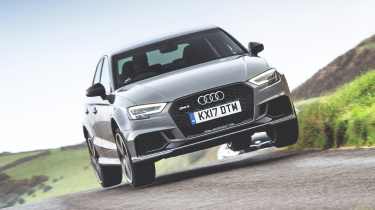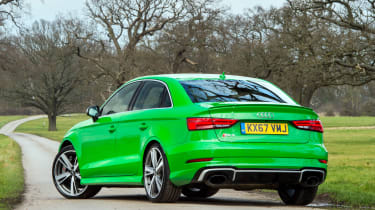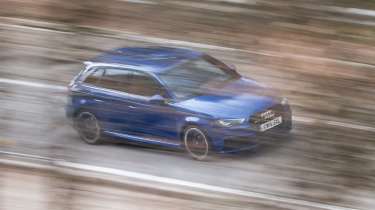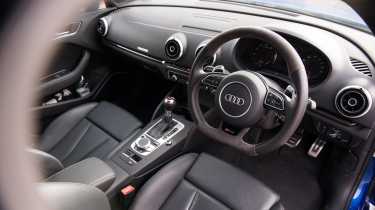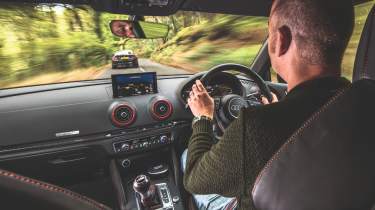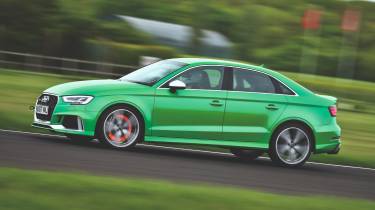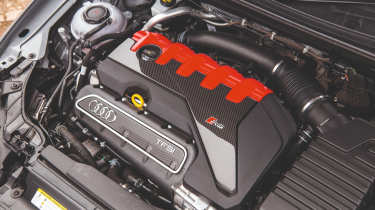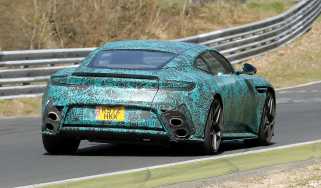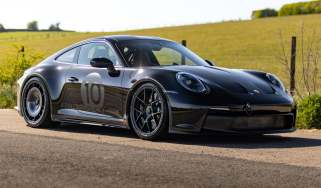Used Audi RS3 (8V, 2015 – 2020), review, specs and buying guide for a hyper hatch bargain
Briefly the most powerful hatch on the planet the Audi RS3 is a great all-rounder with an astonishingly great engine
The hot hatch has come a long way since Audi’s parent company brought us the Golf GTI back in the mid-1970s. Back then a little over 100bhp was enough for a hatch to be very hot indeed and supercars of the day made do with a bit less than 400bhp. Fast forward 50 years and the hottest of hatches, such as the Audi RS3, now have the sort of power that the Countach had when it was launched. The era of the hyperhatch is with us and the RS3 is one of the best.
It may have been usurped by the Mercedes-AMG A45 S as the most powerful of the new breed of ballistic hatches but for a brief period, the Audi RS3 was top dog, thanks to its tuneful and powerful turbocharged five-cylinder that initially delivered 362bhp before its mid-life revamp boosted its output to 394bhp. The benchmark sprint took just 4.3sec and 4.1sec respectively but when we figured the saloon version we managed a sensational 3.7sec for the 0-60mph increment… in the wet!
The RS3 was very quick then, but it wasn’t the most involving of hot hatches. It had four-wheel drive and a twin-clutch gearbox to transform itself into a formidable cross-country machine, boasting enough straight-line pace to trouble far more expensive cars, but it ultimately wasn’t quite as involving as it could have been.
The RS3 doesn’t really inspire you to go for a drive just for the sake of it. Its limits are so great that approaching them requires antisocial levels of speed and commitment, and at a more relaxed pace there’s little (background five-cylinder noises aside) to suggest you’re in anything more extreme than a basic Audi A3.
More reviews
One thing enhances the driving experience almost all the time however: the engine. It makes this car feel genuinely special whether you’re rumbling around town or roaring down an open road. When the exhaust flaps open – at higher revs in Comfort, and almost all the time in Sport – the sound that emerges is almost on-par with the V10 in Audi’s R8, and quite dramatic when pops and crackles emerge from the exhausts with each gearchange.
The RS3 might not be the last word in tactility but it is a great allrounder, perfectly useable on a day-to-day basis, relatively economical given the performance on offer and seemingly having a decent reliability record, too. And the best news is that you can now buy one for a third of the price of a brand new RS3.
Audi RS3 8V in detail
The RS3 8V’s predecessor hadn’t garnered a brilliant reputation during its short life – yes, it was quick, but an uncompromising ride quality, inert steering and a tendency to understeer didn’t win it quite as many fans as its raw specification would suggest. Things would improve with the second generation though.
Launched in 2015 as a five-door Sportback the 8V RS3 used the same recipe as the first gen car, but a series of refinements would mean that it was a better machine. The five-cylinder turbo engine returned impressive numbers – 362bhp from 5550-6800rpm and 343lb ft from 1625-5550rpm, good enough for a 4.3sec 0-62mph time and a 155mph maximum. That latter figure could be boosted to 174mph if you opted for the Dynamic Plus package which also brought Magnetic ride and an RS Sports exhaust for £2495.
> Audi A1 Quattro review – the supermini that cost more than a Porsche
In general the car’s straight-line performance was very good, especially with the quattro four-wheel drive’s ability to put the power down whatever the conditions, especially now that up to 100 per cent of the torque could be sent to the rear axle. It didn’t feel wantonly over-engined, though, and you would be hard pressed to identify the extra power over a VW Golf R without driving them back-to-back. At least the exhaust note was much more evocative although some found the optional sports exhaust a little too much for a hatchback.
The transmission was a seven-speed S-tronic twin-clutch gearbox that swapped cogs cleanly and quickly in auto mode and in the manual setting the shifts themselves were rapid. One downside was that there could be a delay between pulling the paddle and the shift actuation, and when you were really hustling the car you didn’t always get downshifts when you wanted them. Another demerit was the transmission’s behaviour at very low speeds, such as nose-to-tail driving in town and low-speed manoeuvres, where the clutch could disengage quite abruptly and shunt you along inelegantly. It was irritating at first, but the longer you spent with it the more this trait became seriously frustrating.
The interior was typical Audi fare – well built, decent materials – and with a few flashes to differentiate it from the normal A3. There were heated sports seats (optional wingback items were a £795 option), an MMI radio with DAB, Bluetooth, dual-zone climate, an RS steering wheel and a smattering of RS3 logos and posher trim than you’d find in a regular TFSI. Externally you got 19-inch alloys, LED headlights and tail lights and RS body styling. In a subdued colour it didn’t stand out from the crowd too much making it an ideal hatch for those who wanted to travel under the radar.
Big changes came in 2017 with the debut of the four-door saloon at a £950 premium over the hatch) to sit alongside the Sportback while both models received some mechanical and cosmetic upgrades. The major update was to the engine which was going to struggle with new emissions regulations. Thankfully the five-cylinder configuration remained as did the 2480cc capacity but the new engine swapped the old iron cylinder block for a lighter aluminium one and gained a hollow-bored crankshaft, which shed 26kg in the process. Given that was 26kg less over the front axle, it was a promising development.
Its 394bhp output (from 5850-7000rpm) was nine per cent greater than the previous model's 362bhp, and torque had increased too, from 343lb ft to 354lb ft, developed between 1700-5850rpm. Acceleration improved with 0-62mph taking just 4.1sec. Externally the new model could be spotted by its reshaped grille with new angular headlights which sat above newly designed bumpers front and rear. Like the front, the rear lights also gained new lighting graphics and there was a new roof-mounted spoiler. Buyers could also personalise their RS3 via styling packs in aluminium, black or the standard body colour.
Inside the RS3’s design was beginning to look a little dated with items such as the pop-up infotainment screen looking small and unfashionable in the era of wall-to-wall TFT screens. That said, Audi tried to make the cabin more modern, with the biggest change on facelifted versions being the appearance of Audi’s Virtual Cockpit, a 12.3-inch high-resolution screen that had spread across the majority of the Audi range. Standard in the RS3 is Audi’s top spec MMI sat-nav and media system, complete with Google mapping, smart phone mirroring and a BOSE sound system. The optional Bang & Olufsen system was excellent and worth the extra £495. New options such as carbon ceramic brakes were perhaps less appealing at £4695.
What we said
‘Perhaps if Audi riposted with some proper blood and thunder then the RS3 would elevate itself beyond these lingering Golf R thoughts… but it’s just not exuberant enough to do so. It lacks just a little sparkle, that extra edge of excitement you might hope for and expect given the price.
‘Even so, the RS3 Sportback is a compelling package. The engine imparts a sense of occasion, the quality is irreproachable, the chassis has enough adjustability to keep you engaged and there’s grip and traction to spare. The eight-piston callipers that grip the wave-design brake discs are also superb.
‘This Audi lacks the piercing focus of the hardcore A45 AMG but is a more enjoyable, more rounded car and feels much less one-dimensional. On the racetrack it’ll even allow you to throw it into corners in a deliberate near-spin and then pulls you clear in a cloud of smoke and a gale of laughs.
'In fact, given the space to really take the RS3 by the scruff, it displays a really indulgent, fun side. It’s a shame that for the most part on the road it feels just a little uptight. In summary, much better than the old car but nothing like as spectacular as the spec sheet suggests.’ – Jethro Bovingdon, evo 210, July 2015.
9582 miles in an 8V Audi RS3
‘We get all sorts rolling into evo’s car park, from superminis to supercars, but few cause quite such a stir on their entrance as our RS3 did when it first arrived. It wasn’t the bassy gurgle of its sports exhaust-equipped five-cylinder engine that had people out of their seats, but the car’s Viper Green paint finish. Throughout the Audi’s six-month stay with us the £2400 (yes, really) hue was a constant talking point, and most of the chatter was positive.
‘Wherever I went with the car, it would start a conversation or elicit eager thumbs up. There were exceptions, of course, such as the lady who mouthed an extravagant ‘horrible’ from behind the wheel of her VW Touran (that said, she could have been talking about me), but overall it was all extremely positive.
‘The engine was well received by all who experienced it, too, and it got better and better as the miles piled on. Not only did the 394bhp turbocharged five-pot sound epic, emitting a nape-prickling howl that was part Ur-Quattro and part R8 V10, it also delivered a blistering turn of speed – in a similar Audi RS3 in streaming wet conditions I saw 0-60mph in 3.7sec.
‘So it was a shame this magnificent piece of engineering was undermined by the seven-speed S-tronic transmission (there’s no manual alternative). It delivered quick and crisp shifts via the steering-wheel paddles when you were in a burning hurry, but if you took a more laid-back approach, the twin-clutch unit got into something of a muddle. It was at its worst at roundabouts and junctions, where the need to suddenly accelerate would startle it, causing it to engage gears with the subtlety of a dyspraxic bull negotiating a particularly compact yet well-stocked china shop.
‘The chassis proved to be a similarly mixed bag. As you’d expect, the quattro-enhanced traction and grip were phenomenal, and the Audi’s ability to get extremely quickly from point A to point B verged on teleportation. And when the heavens opened, its rock-steady composure gave you the confidence to push on when others were throttling back.
'Yet this focus on ultimate control robbed the car of any real depth. No matter how many times I tried to have a laugh with the RS3, it always remained slightly aloof, unwilling to countenance anything but a (very) fast in and (very) fast out approach to corners. There was next to no adjustability, just a dogged adherence to your chosen line. Only on track and at the absolute limit did the Audi start to loosen up and let its hair down.
‘What couldn’t be faulted was the sheer quality of the car. At £43,765 basic, and nearly £60,000 with options (£4965 carbon-ceramic brakes, £995 upgraded stereo, that paint…), it might sound pricey for what is at its heart an A3, but I never felt shortchanged by the RS3.
‘Even ignoring the colour, it looked the part, all squat and purposeful, while the panel gaps were millimetre perfect. It was a similar story inside, where the elegantly designed cabin and top-notch materials created a classy yet understated ambience. No matter how rough your day had been or how long the journey ahead, climbing into the Audi always instilled a welcome sense of calm. The only real criticism was reserved for the driving position, which was set just a bit too high.
‘Reliability was impressive too, with the only visit to a workshop being for a pair of replacement front tyres after potholes did for both of the skinny-sidewalled 30-profile fronts. And apart from washer fluid and unleaded, there was no need to touch the fluids now that the new five-cylinder has kicked its predecessor’s thirst for oil.
‘I wanted to love the RS3, I really did. The compact sports saloon formula is just so cool, and every time I climbed aboard and fired that magnificent engine into life I got a small tingle of excitement. And when undertaking the daily grind the car was brilliant – overly firm ride aside – mixing effortless pace and refinement with a decent dose of practicality. Yet when I wanted to exploit the RS3’s considerable performance potential, I was always left a little cold by its one-dimensional grip ‘n’ go personality.
‘In the end the glorious five-cylinder engine was both its salvation and curse. Yes, it delivered a memorable soundtrack and epic performance, but despite being 26kg lighter than before (thanks in part to an aluminium crankcase) it was still a hefty old lump, and all that weight over the front axle left the RS3 feeling lead-footed when others were up on their toes. The structurally similar but four-cylinder VW Golf R shows you what can be done with this platform.
‘So I’ll miss the fast and flawlessly finished Audi, but I’m not going to feel green with envy when I see another on the road.’ – James Disdale, evo 253, November 2018
Used Audi RS3 prices and buying guide
Prices start at about £18k and rise to £40,000 for the most recent low milage cars although some modified examples have price tags of up to £50k. Whether you want standard or modified is one of the questions you’ll need to ask yourself, but with a 0-62mph time of around 4sec you do have to ask whether you need your RS3 to be even faster. The engine is tough and can reliably take big power, but it will put undue stress on the other drivetrain components.
The key to keeping an RS3 box fresh is regular servicing and frequent oil changes, not just for the engine but for the S-tronic ‘box that also requires its oil and filter to be regularly refreshed. The box itself is tough, but watch for the traction light flashing on and off which could indicate a faulty Haldex clutch pump. On the engine side a unit that cuts out frequently will need a new fuel pump module.
The chassis is generally well sorted but the optional Magnetic ride does improve ride quality although you’ll probably find Dynamic mode too hard for the road in the UK. Rear shock absorber mounts will be the most likely cause of knocking from the rear. Brakes can wilt under severe use – the eight-pot calipers were fine, but the discs aren’t really up to the job. Aftermarket discs are a worthwhile upgrade.
Check the wheels for damage and corrosion and also see what tyres are fitted – if they’re not a premium brand alarm bells should ring over what else has been skimped on. Some of the optional 19-inch wheels will have 255/30 tyres on the front axle and 235/35s at the back and this helps with turn in. A keener front end can also be assisted by fitting a thicker rear anti-roll bar. There are no real surprises with the interior or the body, both are up to the usual Audi standards but obviously check for mismatched paint and that the LED lights are damage-free.
Audi RS3 8V (Sportback) specs
| Audi RS3 (2015) | Audi RS3 (2017) | |
|---|---|---|
| Engine | In-line 5-cyl, 2480cc, turbocharged | In-line 5-cyl, 2480cc, turbocharged |
| Power | 362bhp | 394bhp |
| Torque | 343lb ft | 354lb ft |
| 0-62mph | 4.3sec | 4.1sec |
| Top speed | 155mph | 155mph |
| Weight | 1520kg (242bhp/ton) | 1515kg (264bhp/ton) |
| Price (new) | £39,955 | £44,300 |
| Price (now) | From £18k | From £24k |
